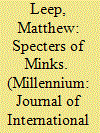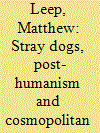|
|
|
Sort Order |
|
|
|
Items / Page
|
|
|
|
|
|
|
| Srl | Item |
| 1 |
ID:
193307


|
|
|
|
|
| Summary/Abstract |
Rats tend to thrive wherever humans do. In recent centuries, the growth of human populations around the planet has meant the growth of a nearly equivalent global population of rats, particularly in cities, where they thrive on trash, food scraps, and infrastructure, and widely stymie human efforts to get rid of them. This forced coexistence has inspired a wide range of human responses, ranging from revulsion and extermination efforts as vermin, to religious veneration and use as experimental lab animals. At the same time, the political figure of the rat has played a constitutive role in violence and experimentation against human populations who are deemed as rat-like. To understand these linked dynamics, the article frames the idea of interspecies internationality, against both Anthropocene and geopolitical readings of the planetary condition. It then elaborates three axes around which rat assemblages have been formed – exterminative, experimental, and ecological. The article concludes by arguing that the rat, as interspecies figure of politics and as living creature, allows us to understand important dynamics around the generation of disposable life, political difference, and conditions of coexistence, in ways that are critical to the entwined politics of life on the planet.
|
|
|
|
|
|
|
|
|
|
|
|
|
|
|
|
| 2 |
ID:
192199


|
|
|
|
|
| Summary/Abstract |
While narrative approaches in International Relations (IR) have become increasingly prominent, posthumanist narratives of capitalism remain on the margins. Informed by feminist avant-garde poet Susan Howe and philosopher Jacques Derrida, I develop a ‘drift narrative’ approach to human-mink relations during the SARS-CoV-2 pandemic, wherein millions of minks in fur farms were infected by the coronavirus and culled. This approach employs the use of postcapitalist elegies constructed in a wildlife refuge located near a mink factory farm. In a context of global mink culls, the wildlife refuge – where minks live freely – proximate to a local industrial mink fur farm – where minks are caged and killed for profit – became the site of (re)writing IR in drift narrative form. This poetic analysis highlights trans-spatial links of animal capital and employs intermixed elegiac images, sound recordings, and textual fragments to help us become attuned to nonhuman dreams, desires, losses, and futures. Grounding persistence for postcapitalist futures within the dreams of the dead, the drift narrative generates a spectral form of global multispecies solidarity. Contributing to the interspecies and narrative turns in IR, as well as multidisciplinary work on multispecies solidarity, the drift narrative offers an aesthetic and ethical critique of past and future animal capital systems that render more-than-human life as killable.
|
|
|
|
|
|
|
|
|
|
|
|
|
|
|
|
| 3 |
ID:
161629


|
|
|
|
|
| Summary/Abstract |
International Relations scholars have recently begun exploring the politics of human-animal relations in global affairs. Building on Jacques Derrida’s work on hospitality and animals, this article theorises possibilities of responsibility to animals in war zones, pushing the limits of what it means to be with and for others regardless of their human or animal otherness. Specifically, I develop a critical account of cosmopolitan belongingness to illustrate how our being on earth is always a ‘being-with’ animal others. In thinking through possibilities of post-human belongingness that could emerge in times of war, cosmopolitanism becomes a futural task, an out-of-time and endless confrontation of past and future opportunities for interspecies togetherness. The theoretical significance of this approach is illustrated with a case study on the killing of stray dogs during the Iraq War. This case reveals a cosmopolitanism calibrated to more fully consider possibilities of human-animal belongingness amidst violence.
|
|
|
|
|
|
|
|
|
|
|
|
|
|
|
|
|
|
|
|
|